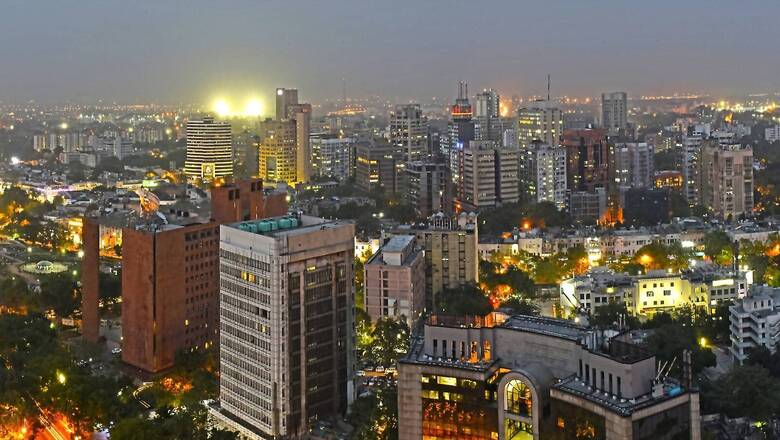
views
Urbanisation is not a mere consequence of faster growth but also an instrument for promoting socio-economic development. India is the second largest urban system in the world. Several estimates point that India will be half-urban in a couple of decades. Such massive and historic transition presents an unprecedented challenge as well as a great opportunity to enable sustainable development.
Over the years, cities have become entangled in repercussions of unplanned urbanisation, which is reflected in mushrooming of informal settlements, traffic and transportation problems, pressure on basic infrastructure, and an overall environmental degradation.
With the launch Swachh Bharat Mission in 2014, India entered a new era of urban development and a year later, a multitude of programmes like Smart Cities, AMRUT (Atal Mission for Rejuvenation and Urban Transformation), HRIDAY (Heritage City Development and Augmentation Yojana), and PMAY-U (Pradhan Mantri Awas Yojana – Urban) brought massive interventions. Nonetheless, city planning—which is a prerequisite for an integrated, sustainable, inclusive and planned urban development—has not received adequate attention of the functionaries and masses.
ALSO READ | Finding the Missing Pieces of Urban Planning Puzzle in India
Unplanned Urbanisation
A large share of urbanisation in India is still untapped, unplanned and unacknowledged. About 8,000 towns are counted as ‘urban’ for population estimation, however half of them, called as census towns, are still administratively ‘rural’. More than half of these settlements do not have statutory master plans, those available face difficulties in implementation.
Secondly, small- and medium-sized towns face vulnerabilities due to rapid growth without adequate planning. Often the land use decisions in cities are made without adequate empirical assessment of their consequences on air quality, climate change, natural drainage system, local ecology, efficiency, affordability, inclusivity, urban economy, and so on.
Cities are ‘engines of economic growth’. If left unplanned, they can create inefficiencies in use of urban land thereby creating affordability issues for the masses. Moreover, efforts to prevent climate change cannot be ensured in such a situation. Urban settlements of all class and size play an important role in urban hierarchy and must not be left unprepared when they need to become the backbone of the economic momentum of the nation.
Role of Urban Planners
Most conversations regarding the present state of cities and lack of planning end with a platitude that the country is constrained due to an acute lack. To bring reforms, capacity building initiatives and dissemination of best practices are often the adopted paths. Though relevant both these pathways have not led to sweeping transformations so far.
NITI Aayog constituted a high level multi-ministerial advisory committee under Vice-Chairman, NITI Aayog, to discuss the question of urban planning capacity in depth. The result of consultations with relevant ministeries, think tanks, academia, urban practitioners etc. resulted in a milestone report on ‘Reforms in Urban Planning Capacity in India’ that was recently released in the public domain. It contains a set of 14 recommendations to overhaul the urban planning practices in the country.
As of today, there are three pillars of capacities of urban planning in India—the public sector, the private sector and the academia. The public sector at the state and city levels is functioning with skeletal machinery for planning of cities. India does not have even one town planner per urban centre in several state town and country planning departments. Moreover, the ‘town planning’ function often gets overshadowed by the building plans’ approvals at urban local bodies.
Cities function with multiple authorities and organisations that often face coordination issues. The private sector in this domain is also at a nascent stage. All of this then impacts the demand for study and research in urban planning sector thereby creating low-quality equilibrium in the private sector. Clearly, the three variants—government as usual, business as usual and education as usual—would not yield the ‘Urban 2.0’ milieu even in the short term.
The role of urban planners has to emerge as that of joining the dots, moderating amongst sector experts and taking balanced decisions. Their role as a licensee has only tarnished the reputation of their profession and tainted their relationship with citizens.
Furthermore, it is not just necessary to increase the number of urban planners in India but it is equally pertinent to cultivate the right methodology of learning, and create a strong ethos towards adoption of evidence-backed planning and technology enabled implementation.
As of now, quite ironically, it is not the qualified planners but graduates from other streams, not trained in ‘planning skills and principles’, who provide services in the urban planning domain. Therefore, a dynamic multi-disciplinary soft capital has to be created in the country that is built upon well-formed minds and adaptive skill sets to think futuristically and act practically. This workforce needs to be regularly upskilled in the public sector, private sector as well as academia to contribute in nation-building.
ALSO READ | India’s Cities are Victims of Outdated Political Economy Constructs
‘Whole of Society’ Approach
To achieve major transformation, India needs to cultivate an ecosystem of civic innovation. Private sector companies need to be nurtured to work with the public sector to suffice town planning functions at the speed and scale that is aspired. An enabling framework needs to be created to make the tools of urban management like building bylaws, acts, value capture policies reflective of the present and future context.
Several experts argue the relevance of statutory city master plans. The fact remains, they are quintessential tools to enable integrated urban development and prevent ad hocism. They face enormous difficulties because of lack of adequate thinking about their forward and backward linkages. Cities also suffer as a result of long delays in finalisation and approval of master plans. The mechanism of plan implementation is very weak. Citizens have become passive consumers of city plans. There is a perceptible communication gap between the plans and the people that needs to be demystified.
At the operational level, urban planning officials at all levels need to be provided regular exposure and trainings. Similarly, the elected municipal leadership has to be empowered with awareness of how integrated urban planning can realise the objectives of socio-economic development.
The model of urban planning that India has been following so far is heavily borrowed from the American models. Car-based city expansion models would not remain relevant in the Indian context in the future. Moreover, given the pace at which technology has been evolving across the world, the present planning practices in India may soon become obsolete. The urban landscape of future is bound to face multiple technological disruptions like electrically powered micro-mobility options, flying cars and digitally printed building blocks. Once they become mainstream, they are bound to drastically change urban living, settlement patterns, and city structures.
It’s about time to initiate ambitious actions with ‘whole of society’ approach. At the central, state and city government levels, there is a compelling need to create robust human, organisational and institutional capacities. A competitive playground needs to be created to nurture entrepreneurial energies in this sector. Also, citizens and their elected representatives need to proactively engage to leverage the opportunity of massive urbanisation that has begun to unfold.
Amitabh Kant is CEO, NITI Aayog. Anshika Gupta is Senior Associate, NITI Aayog. The views expressed in this article are those of the authors and do not represent the stand of this publication.
Read all the Latest Opinions here



















Comments
0 comment